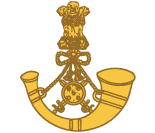Kali Panchwin
| Kali Panchwin (2 Maratha Light Infantry) | |
|---|---|

The Regimental Insignia of the Battalion
|
|
| Active | 1774 to present |
| Country | India |
| Branch | Army |
| Type | Infantry |
| Garrison/HQ | Pune |
| Decorations |
|
| Battle honours |
|
The Kali Panchwin, now formally called the 2nd Battalion, Maratha Light Infantry Regiment, is one of the oldest battalions of the Indian Army. It consists of troops known as Ganpats from Maharashtra in Western India. In the 17th century they formed part of Shivaji's army that defeated Aurangzeb in the Deccan Plateau. It is now part of the Maratha Light Infantry.
Formed in 1768 as the 3rd Battalion Bombay Sepoys, the battalion participated in almost all theatres of action in India and overseas, starting with the siege of Seringapatnam defeating Tipu Sultan. They have seen action in Mysore, Seedaser, Baghdad, Afghanistan, Dadar, Baroda, Burma, China and Palestine.
In World War I, the battalion won the battle honours of Sharon and Nablus in Palestine.
In World War II, the battalion distinguished itself in the Battle of Keren (North Africa), against Mussolini's Italian troops and native Eritreans. The battalion then made history as part of the 4th Indian Division against Rommel's Afrika Corps in the North African Campaign. It continued with victories at Kut-El-Amara and in the Western Desert Campaign at Tobruk under Montgomery. The Battalion was re-raised back in India as it had lost most of its men at Tobruk.
...
Wikipedia
